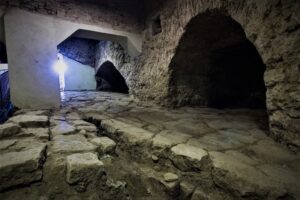Walking Through Etruscan Walls and Gates
Testimonies of the Etruscan Era
In Perugia, significant testimonies of the Etruscan era are still visible, particularly the city wall built between the 4th and 3rd centuries BC. The Etruscan Arch, also known as the Arch of Augustus, was the main entrance of this wall. The overlying loggia and nearby fountain are 16th-century additions.
The Gates of Perugia
Perugia, with its millennia-old history, is surrounded by ancient walls that include numerous historic gates, many of which date back to the Etruscan and medieval periods. Here’s an overview of Perugia’s main gates:

1. Etruscan Arch (Arch of Augustus) The Etruscan Arch is one of the city’s most iconic monuments. Built in the 3rd century BC, this imposing gate is a perfect example of Etruscan architecture. It was originally part of the Etruscan walls surrounding Perugia.
2. Porta Marzia Incorporated into the Rocca Paolina, Porta Marzia is another example of Etruscan architecture. Originally one of the main gates of the city, it was dismantled and rebuilt in the 16th century within the fortress.
3. Porta San Pietro One of Perugia’s medieval gates, Porta San Pietro leads to the Borgo XX Giugno neighborhood. Built in the 14th century, it features a massive structure and an imposing tower.
4. Porta Sole Located in the highest part of the city, Porta Sole offers a spectacular panoramic view. The gate and the surrounding area are named because they are exposed to the sun for much of the day.
5. Porta Sant’Angelo This gate is located in the homonymous neighborhood and is one of the best-preserved gates. Built in the 13th century, Porta Sant’Angelo features a large circular tower.
6. Porta Eburnea Located in the southwestern part of the walls, Porta Eburnea dates back to the medieval period and was one of the main access points to the city.
7. Porta San Girolamo This gate is less known but equally fascinating, with a typically medieval structure. It is located near the church of San Girolamo.
8. Porta Santa Susanna Porta Santa Susanna in the homonymous neighborhood was one of the main gates during the medieval period. The gate has undergone various modifications over the centuries but still retains its ancient charm.
9. Porta Trasimena This gate, also called Porta di Sant’Andrea, is a secondary but historically significant access located in the northern part of the city.
Exploring the Gates
Each gate tells a part of Perugia’s history and offers a glimpse into the city’s Etruscan and medieval past. Exploring the gates of Perugia means taking a journey through time, admiring the ancient walls, and imagining life centuries ago. Don’t forget to walk along the walls to enjoy panoramic views and immerse yourself in the fascinating history of this timeless city.
